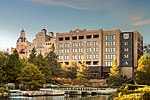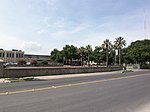F.I.S.H.
2009 establishments in Texas2009 sculpturesAnimal sculptures in TexasFiberglass sculptures in TexasFish in art ... and 2 more
Outdoor sculptures in San AntonioTexas sculpture stubs

F.I.S.H. is an outdoor 2009 sculpture depicting a school of fish by Donald Lipski, installed underneath the 1-35 overpass near Camden Street in San Antonio, Texas, United States. The installation features 25 7-foot (2.1 m) fiberglass resin sculptures of long-eared sunfish, each of which are hand-painted and anatomically correct. One additional fish is displayed inside The DoSeum, a children's museum. The sculpture is part of the collection of Public Art San Antonio.
Excerpt from the Wikipedia article F.I.S.H. (License: CC BY-SA 3.0, Authors, Images).F.I.S.H.
North Pan Am Expressway, San Antonio
Geographical coordinates (GPS) Address Nearby Places Show on map
Geographical coordinates (GPS)
| Latitude | Longitude |
|---|---|
| N 29.439722222222 ° | E -98.481666666667 ° |
Address
North Pan Am Expressway
North Pan Am Expressway
78215 San Antonio
United States
Open on Google Maps





